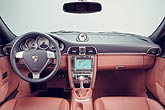Recent Articles
Popular Makes
Body Types
2007 Porsche 911 Turbo First Drive
Forget MPG, get TPM – Thrills per Mile

Porsche 911 Turbo – First Drive: The new 2007 Porsche 911 Turbo sat within yards of the Mediterranean’s crashing surf, pinging and humming as it settled down after miles of hard driving. It was tough to pry myself out of the body-hugging leather sport seats and take a rest (not least because they’re actually than in the previous model), but a few minutes of repose seemed prudent and the scenery was compelling. Just eight miles away, across the Straight of Gibraltar, lay the coast of Africa. The Rif Mountains of Morocco seemed close enough to touch. They looked dusky-purple, mysterious and exotic. But the schedule wouldn’t allow a visit to Africa; Porsche lent me the new 911 Turbo for the day to drive around southern Spain and it was overdue back at the hotel in Benalup, a small town about 30 miles inland. Not that we would have visited Morocco anyway. The U.S. Department of State recommends that Americans visiting Morocco keep a low profile and cruising around a poor country in a $122,900 sports car is hardly traveling incognito. Besides, I’ve seen , and you can’t be guaranteed that when you enter Morocco you’ll be able to leave Morocco. So, I left the beach and turned inland, resuming my joyride on the winding roads of Andalusia, pressing the 2007 Porsche 911 Turbo hard, reveling in the song of its 480-horsepower, twin-turbo 3.6-liter flat-six, and taking full advantage of the tenacious grip provided by the new Porsche Traction Management (PTM) all-wheel drive system. It’s a ride I’ll never forget.
Overview
Overview The Porsche 911 Turbo is loaded with technology, but purists needn’t worry. PTM, PSM, and PASM all work to enhance the driving experience, rather than ruin it. Purists may cringe, but the assistive technology that comes standard on the new 2007 Porsche 911 Turbo goes a long way toward making this one of the greatest sports cars extant. Porsche Traction Management (PTM) ensures that power is split perfectly between the front and rear wheels and also helps to keep you between the white lines. Also included, but somewhat redundant due to PTM’s comprehensive vehicle control, is Porsche Stability Management (PSM), which uses the brakes to prevent oversteer and understeer and other forms of unwanted directional change. Porsche Active Suspension Management (PASM) allows the driver to select either the still-dynamic-but-slightly-more-cushy Normal mode or the I’m-going-to-thrash-this-road Sports mode, the system automatically adjusting the suspension dampers accordingly. Each of these high-tech helpers enhances the 911 Turbo experience. Leather upholstery and trim is also standard in the new 911 Turbo, fitting given the price tag. Thankfully, it decorates the more attractive and comfortable interior that debuted on the current generation 911 Carrera two years ago. To separate the 911 Turbo from its plebian brethren, it also includes a specially-designed gear shift and “Turbo” logos on the door sills. Porsche also replaced the old audio system with a 13-speaker Bose surround sound audio system and added a navigation system, too. Of course, Porsche would be remiss if it didn’t imbue its super machine with a generous array of safety features, including the same braking system as used on the Porsche Carrera GT supercar – six-piston fixed caliper brakes with pads and discs that are larger than the previous model’s. There are also six airbags, including side-impact protection that consists of a thorax and head airbag for the driver and front passenger. Like all Porsches, there’s an extensive option list and a 54-page ordering catalog from which you can choose myriad items to customize your new 911 Turbo, with features ranging from ceramic composite brakes ($8,840) to the Porsche crest embroidered on the headrest ($270). It’s possible to spend tens of thousands of dollars on Porsche options, so think carefully about whether you really need a Sycamore wood steering wheel ($620) before signing your order form. One tempting item is the Sports Chrono Package Plus ($1,850), which, at the push of a button, makes all sorts of wonderful things happen, including increasing the turbo boost by 2.9 psi for 10 seconds, bumping torque by 10 percent and taking 0.2 seconds off the Turbo’s already sizzling 0-60 acceleration time of 3.7 seconds.
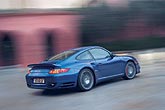
Nuts and Bolts
Nuts and Bolts With 60 more horsepower and 44 more lb.-ft. of torque, the 2007 Porsche 911 Turbo is the most powerful 911 in history, able to accelerate to 60 mph in just 3.5 seconds with the optional Sport Chrono Package Plus. Mechanically, the biggest change and improvement to the 2007 Porsche 911 Turbo is a new turbocharger that uses specially-designed materials that can handle very high temperatures up to 1,830 degrees Fahrenheit. With this upgrade, one turbocharger can handle exhaust gases that used to be split between two and can use that exhaust energy for longer than before. Of course, the new 911 Turbo has two of these units, which accounts for the fact that at 480 horsepower it’s got more power than any 911 in history – 60 more than the previous model – despite having the same sized 3.6-liter engine. Torque is also increased from 413 lb.-ft. to 457 lb.-ft., available across a much wider range between 1,950 rpm and 5,000 rpm. These changes make the new 911 Turbo faster and more responsive to throttle inputs – both very good things. It doesn’t get as much attention as the increased power, but the 911 Turbo’s new all-wheel-drive system is the first actively controlled AWD system in a 911. By comparison, the system in the Carrera 4S uses a mechanical viscous coupling to transmit power to the front wheels, only reacting after rear wheel slippage is detected. The new electronically-controlled AWD system in the 2007 911 Turbo, called Porsche Traction Management (PTM), uses sensors to constantly monitor changes in driving conditions such as acceleration, wheelspin, oversteer, and understeer. PTM then reacts within milliseconds (Porsche says 100 at the most) to deliver perfect levels of power to all four wheels for optimum performance and control. The system is no killjoy, though. It’s designed to allow quite a bit of leeway, especially at low speeds, so you can get the back end loose on corners before it interferes. The new 911 Turbo also includes Porsche Stability Management (PSM), which includes enhanced brake functions such as pre-loading of the brakes, which detects when you abruptly lift your foot off the gas pedal and then instantly pumps brake fluid from the PSM control unit to the brakes, readying them for action before it even feels your foot on the brake pedal. PSM also allows for a certain level of brake pressure without applying maximum brake force so you can “feather” the brakes to retain forward momentum. The end game of all this technology is to provide you with the most exhilarating ride possible while maintaining control. At the same time, it’s designed to work behind the scenes so you don’t even know it’s there. It’s so good most drivers get fooled into thinking they’re better drivers than they actually are – and that’s worth every penny of the Porsche 911 Turbo’s $122,900 sticker.

Design
Design Despite the addition of an AWD system, the new 2007 Porsche 911 Turbo weighs less than the old model, giving it a power-to-weight ratio that beats Ferrari’s 599 GTB. The 2007 Porsche 911 Turbo is the first 911 to feature aluminum doors. Weighing just 24 lbs. total, they take 31 lbs. off the car’s total weight. In fact, the entire car, despite the addition of an all-wheel drive system, is 12 lbs. lighter than the previous model. At 3,495 lbs, its power-to-weight ratio is an impressive 1.4:1 or 1.4 hp per pound – that’s very close to the Ferrari F430 at 1.5:1 and the Ferrari 599 GTB at 1.6:1. That’s some pretty good company. Of course, quality cannot be expressed in power-to-weight ratios alone. After all, the Dodge Viper boasts a 1.5:1 ratio, but it’s nowhere near as sophisticated as the Ferraris and the Porsche. For instance, despite the new 911 Turbo’s wider dimensions and larger wheels, Porsche managed to retain the drag coefficient of the previous 911 Turbo while also increasing downforce. Increased downforce keeps the tires on the road, resulting in better handling, even at higher speeds. This was accomplished by tweaking the body and trim, and adding things like a new spoiler lip on the front air dam and changing the shape of the air vents that cool the brakes and engine. This is exactly the kind of effort and attention to detail that you’d expect from one of the world’s greatest sports car makers, and helps to explain the stratospheric price tag.
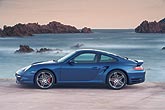
Driving Impressions
Driving Impressions Nothing can slow the Porsche 911 Turbo’s momentum, save a flock of Andalusian sheep and a real, live, honest-to-God shepard. Staying off Andalusia’s main roads for most of the journey, instead sticking to two-lane highways that followed the contours of the countryside and passed through the region’s small towns, I reveled in the Porsche 911 Turbo’s sheer driving pleasure. Carving through valleys and blasting up every straightaway with the carefree élan of a spoiled playboy, the 911 Turbo displayed supreme handling thanks to its sucker-like grip. It was a treat to rip through S curves and over small hills without so much as an inch of slip, the 911 a magnet zipping around a metallic landscape. At lower speeds, such as when climbing a series of switchbacks to a mountain summit, the Turbo allowed a bit of drift that thrilled every time the tires scrabbled for, and then found, grip on the gravel shoulder. Our test car was equipped with the six-speed Getrag manual transmission. Porsche says the five-speed Tiptronic S automatic transmission shifts much faster than any human can, resulting in even faster 0-60 acceleration times than the manual. We know these F1-style shifters are all the rage in modern supercars, but we loved the manual gearbox nevertheless. It felt precise and mechanically perfect with fluid shifts that slotted satisfyingly into place. I never came close to the Turbo’s top speed of 192 mph. It was more fun to leave it in third gear, regardless of how fast the car was going, so I could listen to the sonorous turbocharged, six-cylinder, 480-horsepower boxer engine wind itself up. Plus, third gear provided instant access to the engine’s 457 lb.-ft. of glorious torque, so that when I caught up to a slower vehicle it was, quite literally, a snap to put it behind the 911 and getting smaller in the rearview mirror. The one time I conceded to slower traffic occurred after rounding a bend and encountering a flock of sheep that has swarmed over the road like a wooly avalanche. The shepherd (an actual shepherd!) was dressed in a flat cap, pants tucked into rubber boots, and he carried a wooden staff. With the help of his hyper collie, he moved the flock to one side and let the 911 Turbo through. The sound of all those bleating animals drowned out the Porsche’s burbling baritone, but it was one of those foreign travel experiences that make a trip. Even moseying along at sheep speed, the 911 Turbo was comfortable, not biting at the bridle and lunging to go faster. It was as accommodating at city street speeds as it was electrifying when we pushed it on wide open roads. Our test car was not equipped with the optional Sport Chronos Package so I did not get to try the overboost feature, but with no opportunity for burn-outs it would have been a moot point. When I finally reached the hotel after taking multiple trip-extending detours, or “long cuts,” I stood and looked at the new 2007 Porsche 911 Turbo, lingering over its classic shape and recalling the highlights of the drive. In the final analysis, the 2007 911 Turbo is as complete a Porsche as I have ever driven.
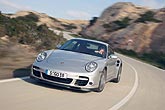
FAQs
FAQs On sale right now, the 2007 Porsche 911 Turbo is the fastest 911 ever, racing to 60 mph in as few as 3.5 seconds. When can I get a 2007 Porsche 911 Turbo? The 2007 Porsche 911 Turbo arrived in showrooms on July 8, making it available right now. What’s this about the new Porsche 911 Turbo having an overboost button? Optional for the 2007 Porsche 911 Turbo is the Sports Chrono Package Plus ($1,850), which, at the push of a button, makes all sorts of wonderful things happen. Turbo boost increases by 2.9 psi for 10 seconds, bumping torque by 10 percent and taking 0.2 seconds off the Turbo’s already sizzling 0-60 acceleration time of 3.7 seconds. Is the 2007 Porsche 911 Turbo the fastest 911 Turbo ever? Yep. In fact, it’s the first 911 Turbo to reach 60 ph in less than four seconds – 3.7 seconds, in fact. Spring for the optional Sports Chrono Package Plus and the overboost function drops that to 3.5 seconds!
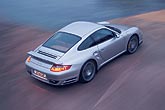
Specifications
Specifications The 2007 Porsche 911 Turbo starts at about $125,000 and rises rapidly from there depending on how many options you select from the 54-page accessories catalog. Test Vehicle: 2007 Porsche 911 Turbo Base Price: $123,695 (including the $795 destination charge) Engine Size and Type: 3.6-liter, twin-turbocharged flat-six Engine Horsepower: 480 at 6,000 rpm Engine Torque: 457 lb.-ft. between 1,950 and 5,000 rpm Transmission: Six-speed manual Curb Weight, lbs.: 3,495 EPA Fuel Economy (city/highway): 18/25 mpg Length: 175.2 inches Width: 72.9 inches Wheelbase: 92.5 inches Height: 51.2 inches Max. Seating Capacity: Four Max. Cargo Volume: 3.7 cubic feet Competitors: Aston Martin DB9/V8 Vantage, Chevrolet Corvette Z06, Dodge Viper, Ferrari 599 GTB, Ferrari F430
Photos courtesy of Porsche cars North America
